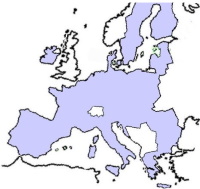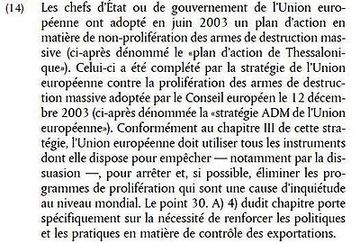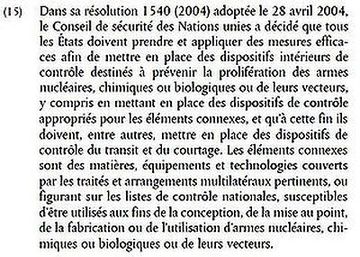|
|
EXPERTISE CUSTOMS Dual-use goods
|
En > Fr |
|
The Technidouanes expert indicates in a detailed technical report whether or not an industrial good is subject to export controls. His service is useful because the complexity of European and American regulations. For for security reasons, dual-use items and goods subject to restrictive measures on exports to certain countries (Russia, North Korea, etc.) are subject to "prohibitions" and are therefore either prohibited from export, transit, or trade; is subject to authorization. Export controls of these The so-called "strategic" products and technologies are intended to avoid possible diversions from their normal civilian uses.
The dual-use items listed by the European Union are fully visible by clicking on the links Following: |
||||||
|
|
||||||
|
In France, double goods The provisions of the Rules of Procedure of the European Parliament and the European Parliament are subject to the provisions of the Council of No. 2021/821 of 20 May 2021 as amended , stating in Article 2: "Dual-use items are defined as products, including software and technologies, which may have a both civilian and military; They include all of the property that can be used for both non-explosive and enter in any way into the the manufacture of nuclear or other weapons Nuclear Explosive Devices;" Historical BDUsSuite the attacks of September 11, 2001 in New York and the terrorist threats following the events in Iraq and in Afghanistan, tighter controls on goods to be was introduced by the recast of the Council of the European Union No. 1334 of 22 June 2000 to by means of Regulation of the Council of the European Union No 428/2009 entered into force on 27 August 2009 and amended to new by Regulation 2021/821 which entered into force on 30 September 2021; and, in France, by publication in the JORF decrees and orders modifying the organization of the controls, then Law 2011-266 of 14 March 2011 on the fight against the proliferation of weapons of mass destruction and their means of delivery. Regulation BDUsConsidering Introductory recitals 14 and 15, the Regulation No 2021/821 follows up on the Union's commitments European Commission in Thessaloniki on 19 and 20 June 2003 by the Declaration of the European Council on Weapons of Destruction (then to the one in Brussels on 12 December 2003), and results from the Resolution No. 1540 of the Security Council of the United Nations United Nations of 28 April 2004 for Combating the proliferation of weapons of destruction and their vectors:
The dual-use items (DUBs) are listed in Schedule 1 to the Regulation 2021/821 as amended by Commission Delegated Regulation (EU) No. 2023-2616 of 15 September 2023. Those are divided into ten categories (from 0 to 9) The lists drawn up by five international bodies:
The application of this regulation is at the expense of the service Dual-Use Goods (SBDU) created by order of the 18 March 2010 (JORF of 20 March 2010), which depends on the Directorate-General for Enterprise DGE, formerly (DGCIS) at Ministry of Industry. A commission Interdepartmental Dual-Use Goods Initiative, created by Decree of 18 March 2010, chaired by the Ministry of Foreign Affairs, the secretariat of which is provided by the SBDU, is referred to in the event of difficulties of interpretation of this European regulation. The headings of the list of goods to be dual-use are divided into articles and paragraphs to from categories 0 to 9 listed above |
||||||
|
The Ministry of Industry (DGE/SBDU) has communicated on its website the provisions of the regulations in force (updated on 19.05.2022).
Ranking of the BDU in the Customs Tariff (CN)In his guide on the export of dual-use items published on its website, the indicates that each tariff heading corresponding to an asset that may fall within the scope of the regulation of BDUs, is associated with a positive referral a code (known as the National Additional Code = CANA) indicating that a control regulation may be imposed on it. applicable. This system is a operator information system and a control tool for the customs service; It is based on the "table of justice". correlation" between the codes of the nomenclature combined with those on the dual-use list. Also The "Consultation" database TARIC" online on the European Union website, that mentions the BDU codes at the bottom of the page of the sections "restrictions", is based on this correlation table set updated annually by the European Commission and feeds, in terms of the classification of goods in duplicate use, national computer reporting systems customs duties of the Member States . That table remains inaccurate because the BDU codes do not match than in the articles or the first paragraphs of the list of dual-use items, while latest version of this list of BDUs are made up of multiple paragraphs and subparagraphs Alphanumeric. In addition, it fosters the suspicions of the Customs Controllers' Share Resulting in Blockages of goods free for export and without Can be used in manufacturing or use weapons of mass destruction or their means of delivery; or Again, from the Directorate-General of the Treasury of the Ministry of Finance, untimely blockages advance payments or payments impeding exports while to be lawful.
Licenses ExportDual-use items are considered as being subject to prohibitions within the meaning of Article 38 of the Customs Code, but may benefit from Derogations for export and transit operations and brokering, in the form of individual licences, general or global, now issued by the dual-use assets of the companies of the Ministry of Industry (DGE), after any opinion of the Intermediary Committee on dual-use items. Operation customs controlsIn application of the Customs Code, customs offices carry out documentary (or physical) checks as soon as the declaration or go back four months (1st level ex-post controls), while the regional and national surveys are three years in Rear (2nd level ex-post controls). Exporting without a dual-use licence, or any constituting an "export without declaration" prohibited goods" within the meaning of Article 426 of the Customs Code is considered to be a customs offence under the second paragraph of Article 414 of the Customs Code. This Additional paragraph of Article 414 of the Customs Code (effective January 1, 2014) is the result of Law 2011-266 of 14 March 2011 pursuant to Article 24 of Regulation No 2021/821 inviting Member States to legislate on the application of this European text. They can drive the seizure of the goods (and their means of transport) transport), the interception by customs of goods in transit, fines of up to three times the value of the goods, as well as a Maximum prison sentence of 5 years.
In Application of Article 411-6 of the Criminal Code, offences for the act of delivering or making accessible to a foreign power, to a foreign or foreign-controlled enterprise or organization or to their agents any information, processes, objects, documents, computerized data or files the exploitation, disclosure or collection of which ... , resulting in even harsher penalties may be noted by judicial customs officers, or police officers with retroactivity of ten years.
Ranking "Unlicensed" goodsThe Dual-Use Classification (DUB) Competence is now part of the new department of the DGE. However, the documentary and physical control of the goods declared for export remainder of the Customs Administration (DGDDI) which can apply the rules of prohibitions; Similarly, Financial Settlements for Exports, Transit and brokerage may be controlled by the general management Treasury and Economic Policy Department (DGTPE) and be subject to prohibitions. Any operation wrong can thus lead to suspicions on the part of the administrative authorities leading to delays or to unnecessary hassle. In his guide to the export of dual-use items, The customs administration recommends that manufacturers ask the DGCIS (SBDU) to confirm rankings Negative effects of non-affected high-tech products through the manufacture of weapons of mass destruction, in order to avoid barriers to exports. It consults with the SBDU in case of doubt about the strategic nature of a product, material, or equipment. This procedure presents the risk to the exporter of obtaining an arbitrary ban on the export of its equipment in Application of the provisions of the "catch-all clause" if they apply to the SBDU for classification, or a Blocking in customs for several weeks of the declared goods, or even a financial blockage of the on the part of the Directorate-General of the Treasury.
The Restrictive export measures on goods other than those on the European list of duplicate goods use but also subject to prohibitions in the meaning of Article 38 of the Customs Code. In the event of their export without a license, so they are also liable to penalties under section 414 (2) of the Customs Code.
The "catch-all clause"The article 4 of the so-called "catch-all clause" regulation gives The power of Member States to ban exports goods not included in the list given in Annex I, "if Supervisory authorities are aware of a risk misuse of the property for the purpose of production or the use of weapons of mass destruction or their vectors". In this case, the DGE notifies This prohibition on the person concerned and the goods is prohibited within the meaning of Article 38 of the French Securities Code, customs, or requires the issuance of a licence for use control final. The reasons for that prohibition shall not be stated in accordance with the the provisions of Article L311-5 of the French Securities and Exchange Code. relations between the public and the administration, because it results from France's foreign policy. The violation of this prohibition is considered to be an "export" without declaration of prohibited goods" subject to severe criminal penalties under the Article 414 of the Customs Code. This clause also applies if the exporter is informed possible misuse for malicious purposes of a equipment or technology that is free for export. Based on the definition of duplicate property use given by the SBDU, in accordance with this regulation European dual-use items are: "Property, equipment - including technologies, software, intangible or intangible know-how – likely to have both civilian use military or capable - in whole or in part - Contribute to the development, production, handling, operation, maintenance, storage, detection, identification, Dissemination of mass destruction" (WMD - nuclear, biological, chemicals, etc.). The official definition is given in Article 4 of Regulation No 2021/821, as amended, by that sentence: "... the property in question is or may be intended, in whole or in part, to contribute to development, production, handling, operation, maintenance, storage, detection, identification or dissemination chemical, biological or nuclear weapons, or other nuclear explosive devices or development, production, maintenance or storage of missiles that can be used as delivery systems for such weapons." The term "mass destruction" corresponds, for example, to the devastation caused by two World Wars and Local Wars in Vietnam, in Iran and Iraq, in Aghanistan, or for the past two years in Syria. These terrible conflicts have led to the extermination of populations in cities or valleys Whole. Also, from a legal point of view, the 'catch-all clause' in Article 4 of Regulation No 2021/821 as amended may be implemented for goods not listed in Annex I to that regulation, but still capable of producing equivalent extermination costs. This "catch-all clause" results from transposition into law at the same time:
The MTCR recommends that governments to control "exports" intended to be used, in whole or in conjunction with with systems for launching weapons of destruction other than manned aircraft." However, this does not preclude an airliner intended for Be piloted by suicidal and inexperienced pirates with sophisticated navigation systems included in the list of dual-use items for the purpose of Hitting a precise target at a speed of 800 km/h Civilian helicopters, tear gas and OtherThe assets in question, which can be used for the law enforcement, are regulated national regulations in accordance with the regulations European Dual-Use Items, which allows Member States to publish restrictive regulations for reasons of security. Procedures and controls have also been the same for those goods not included in the European.
Some regulations made pursuant to resolutions of the Council United Nations Security and Foreign Policy and the European Union's Common Security Agreements prohibit imports and exports of goods listed in the annexes, or allow derogations, under in the form of licences, for proven civilian uses. The licensing and control procedures are the same as in the case of dual-use items. The restrictive measures against these countries result from of the many resolutions passed by the Council of United Nations security. Those against Iran were following the adoption of the resolution No. 1929 of 9 June 2010 by the Council of security of the United Nations, through a decision of the Council of the European Union of 26 July 2010, published in the Official Journal of the Union European Union No. L 195 of 27 July 2010. Now, the countries subject to international sanctions are subject to a table of import and/or export trade restrictions published by the Directorate General of Customs and Excise Taxes; All Export restrictive measures are detailed and regularly updated on the site of the Directorate-General of the Treasury of the Ministry of Finance. Countries whose property is subject to prohibitions published by the European Union in application of sanctions are cited in The Restrictions section of the DG of the Treasury. The countries concerned are: Belarus, North Korea, Iran, Iraq, Russia, Somalia, Syria and Venezuela.
U.S. regulation of Export Controls East reproduced in the pages of this site entitled: Export Administration Regulations (EAR)The USA, Strategic Goods Fall Under Section 774 of Export Administration Regulation (EAR) in the Electronic Code of Federal Regulations (eCFR) , which is titled Trade Control List (CCL), and whose Classification numbers, called Export Control Classification Number (ECCN) are coded on the same principle as the list European dual-use goods, i.e. Annex I to Regulation No 2021/821. But to these articles and paragraphs from the lists published by the schemes multilateral control panels, the U.S. is adding headings called:
These three lists added to the Multilateral Counter-Arms Regimes Mass destruction correspond respectively to goods produced in the USA for which a license is U.S. export is required for various Reasons depending on the country of destination or addressee. These lists, although quite complete in this respect, that relates to the strategic nature of the assets in question are not exhaustive and do not preclude the application of The "catch-all clause" for goods suspected of a malicious destination.
Last updated in March 2024
|


